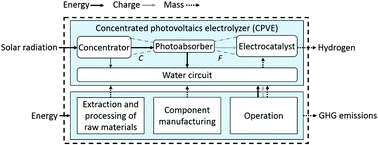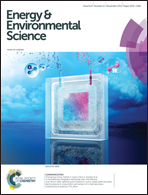Design guidelines for concentrated photo-electrochemical water splitting devices based on energy and greenhouse gas yield ratios†
Abstract
Solar irradiation concentration is considered a viable strategy for reducing the energy and financial investment of photo-electrochemical hydrogen generation. We quantified and compared the sustainability benefit of this approach to non-concentrating and conventional approaches using life cycle assessment coupled to device performance modeling. We formulated design guidelines to reduce the environmental impact of a device. Model devices were composed of a concentrator module (with tracking, supporting, and framing components), photoabsorbers, membrane-separated electrocatalysts, and a cooling circuit. We selected eight concentrator types covering five concentrating technologies. For each device we studied the effect of the irradiation concentration ratio, electrode to photoabsorber area ratio, manufacturing requirements, incoming irradiance, and efficiency of components on sustainability utilizing two indices: (i) the energy yield ratio, and (ii) the greenhouse gas yield ratio. Both indices combine the performance of the system and its environmental impact. Two design guidelines were formulated based on the analysis: (i) any concentration-stable photoabsorber and electrocatalyst are equally feasible at concentrations larger than 55, as their performance prevails over their energy demand, and (ii) the system needs to be designed at an optimum concentration which depends on: performance, the relative surfaces of the photoabsorber and electrode, and irradiance. This study quantified and confirmed that concentrating solar irradiation has a beneficial effect on sustainability, energy yield, and greenhouse gas emissions compared to non-concentrated approaches. This was true for all concentrating technologies investigated. Consequently, this study provides an eco-performance-based rationale to further pursue the research and development of concentrated photo-electrochemical devices.


 Please wait while we load your content...
Please wait while we load your content...